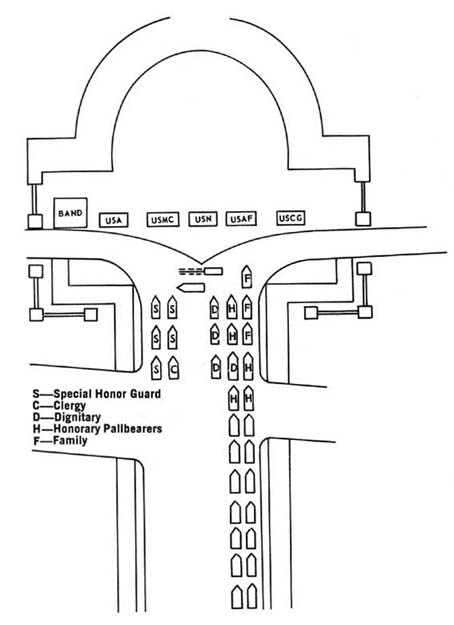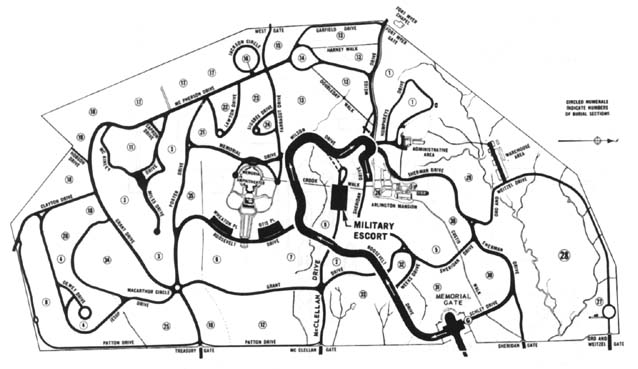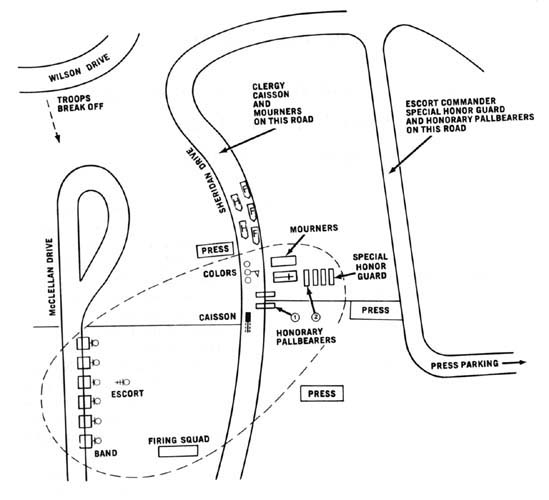|
The
Last Salute: Civil and Military Funeral, 1921-1969
CHAPTER XVII
Former Chief of Naval Operations
Fleet Admiral William D. Leahy
Special Military Funeral
20-23 July 1959
Fleet Admiral William D. Leahy, former Chief of Naval Operations and
personal Chief of Staff to Presidents Franklin D. Roosevelt and Harry
S. Truman from 1942 to 1949, died at the U.S. Naval Hospital in Bethesda,
Maryland, on 20 July 1959 at the age of eighty-four. He was given a
Special Military Funeral on 23 July.
Under policies published the year before Admiral Leahy died, the service
of which he was a member was responsible for coordinating arrangements
for the Special Military Funeral. In this instance the responsibility
rested with the Commandant of the Potomac River Naval Command, Rear
Adm. Elonzo B. Grantham, Jr. Dignitaries asked to participate in or
attend the ceremonies received invitations from the Secretary of the
Navy; the Office of the Chief of Naval Personnel dispatched these invitations
and recorded the responses.
The ceremonies planned by Admiral Grantham and his staff, with due regard
for the wishes of Rear Adm. William H. Leahy, son of the fleet admiral,
followed, with one exception, the general prescriptions for a Special
Military Funeral. The body of Admiral Leahy was to lie in Bethlehem
Chapel at the Washington National Cathedral from noon on 22 July until
the same hour on the 23d; the funeral service was to be held in the
nave of the cathedral at 1400 on 23 July; and burial was to take place
in Arlington National Cemetery. The gravesite was in Section 2, about
midway between Memorial Gate and the Memorial Amphitheater.
The exception to the prescribed ceremonies had to do with the formation
of the main funeral procession, an exception for which there was precedent
in the recent funeral for Deputy Secretary of Defense Donald A. Quarles.
In the 1958 plan, the main procession for a funeral in which burial
was to take place in Arlington National Cemetery was to form at Constitution
Avenue and 15th Street, N.W., in Washington. The body was to be brought
to this point by hearse from the place where the funeral service had
been held, transferred to a caisson, and taken to Arlington National
Cemetery in full procession. But in the ceremonies for
[143]
Admiral Leahy, as in the funeral for Secretary Quarles, a motorized
cortege was to take the body of the admiral from the Washington National
Cathedral to the Memorial Gate of the cemetery. The casket was to be
transferred from hearse to caisson at that point in the presence of
a military escort standing in formation on the lawn nearby. The full
procession was then to enter the cemetery and proceed to the gravesite
for the burial service.
On 22 July the body of Admiral Leahy was placed in Bethlehem Chapel
of Washington National Cathedral. A Navy ceremonial guard from the US
Naval Air Station in Anacostia, D.C., formed the honor cordon and provided
the personal flag bearer. The body bearers were a joint group of ten
enlisted men, two each from the Military District of Washington, Headquarters
Command of the Air Force at Bolling Air Force Base, Coast Guard headquarters
in Washington, Marine Barracks in Washington, and the Naval Station.
One of the two men from the Naval Station was the petty officer in charge
of the group. Each of these agencies also provided one officer and nine
men for the guard of honor to stand watch for the twenty-four hours
that the body was to lie in Bethlehem Chapel.
Composing a special honor guard were General Lyman L. Lemnitzer, Army
Chief of Staff; Admiral Arleigh A. Burke, Chief of Naval Operations;
General Curtis E. LeMay, Air Force Vice Chief of Staff, who represented
the Chief of Staff; General Thomas D. White; General Randolph M. Pate,
Commandant of the Marine Corps; Rear Adm. James A. Hirshfield, Assistant
Commandant of the Coast Guard; and General Nathan F. Twining, Chairman
of the Joint Chiefs of Staff. Eleven friends of Admiral Leahy, one of
whom was an academy classmate, served as honorary pallbearers. Officer
escorts for the honorary pallbearers were furnished by the Naval Intelligence
School at the US Naval Air Station in Anacostia.
According to protocol, announcements of the funeral service for Admiral
Leahy, which in effect were invitations to attend, were sent to all
branches and principal agencies of the federal government and to the
diplomatic corps. Invitations also were extended to all active and retired
admirals of the Navy and Coast Guard, all active and retired generals
of the Marine Corps, and all active generals of the Army and Air Force
living in the Washington area. Among friends and associates of Admiral
Leahy invited to attend, including those asked to serve as honorary
pallbearers, those residing outside Washington received invitations
by telegram. The honorary pallbearers were Fleet Admiral Chester W.
Nimitz; Admiral Thomas C. Hart (retired) ; Admiral Charles P. Snyder
(retired) ; Admiral Louis E. Denfeld (retired) ; Admiral Arthur W. Radford
(retired) ; Admiral Jerauld Wright; Admiral Robert L. Dennison; Vice
Adm. Edward L. Cochrane (retired) ; Rear Adm. Henry Williams (retired)
; Rear Adm. Joseph H. Wellings; and William D. Hassett.
Two Navy agencies located in the Washington area, the Navy Communication
Station and the Naval Security Station, furnished officers and men to
usher
[144]

Diagram 35. Route of march, Washington National Cathedral
to Arlington National Cemetery.
[145]
guests to their seats for the funeral service. The service itself was
conducted by a Navy chaplain, Capt. John B. Zimmerman.
Following the short service at 1400 on 23 July, a motorized cortege
formed outside the cathedral to escort the body of Admiral Leahy to
Arlington National Cemetery. As the body bearers carried the casket
out of the cathedral and through the Navy honor cordon to the hearse,
the US Marine Band, in formation near the honor cordon, sounded ruffles
and flourishes and played a hymn.
The cortege moved to the Memorial Gate of Arlington National Cemetery
by way of Woodley Road, 34th Street, Massachusetts Avenue, Rock Creek
Parkway, Memorial Bridge, and Memorial Drive. (Diagram 35) The
military escort of some 550 officers and men, commanded by Admiral Grantham,
stood on line on the green at the gate, facing the cortege as the motor
column approached on Memorial Drive. In addition to the commander and
a staff of four, one field grade officer or the equivalent from the
Army, Marine Corps, Air Force, and Coast Guard, the escort consisted
of the US Navy Band and a company each from the Army (3d Infantry),
Marine Corps (Marine Barracks), Navy (Navy Air Station), Air Force (Headquarters
Command), and Coast Guard (Coast Guard headquarters). Each company had
four officers and eighty-five men and was organized with a company commander,
guidon bearer, and three platoons, each consisting of a platoon commander,
right guide, and three nine-man squads. Also present at the gate were
the national color detail of three men, an Army color bearer and one
color guard each from the Marine Corps and Air Force, and a personal
color bearer from the Navy.
On the street in front of the escort and facing south toward Roosevelt
Drive in the cemetery were the caisson and caisson detail, furnished
by the 3d Infantry, and the body bearers, who along with the color detail
had come from the cathedral by a separate route in order to reach Memorial
Gate ahead of the cortege.
When the motorcade reached the gate, the vehicles carrying the special
honor guard and the clergy halted on the left side of the street. The
others lined up on the right, with the family cars and those bearing
the honorary pallbearers and dignitaries at the front. (Diagram 36)
After the cortege was in place, the hearse was driven to a position
at the left and slightly ahead of the caisson. As the Navy Band sounded
ruffles and flourishes and played a hymn, the body bearers removed
Admiral Leahy's casket from the hearse, which was then driven away,
and placed it on the caisson. After this brief ceremony, the escort
commander led the procession into the cemetery.
From a distant position in the cemetery, the saluting battery of the
3d Infantry fired a slow-paced 19-gun salute as the procession marched
to the gravesite. The escort units moved via Roosevelt and Wilson Drives,
then turned right and marched off the roadway across the grass to McClellan
Drive. Moving on McClellan to a point almost due south of the gravesite,
the escort units formed on line along the edge of the road facing north
toward the grave. In front of them,
[146]

Diagram 36. Formation at Memorial Gate.
[147]
on the grass between McClellan and Sheridan Drives, stood a squad ready
to fire the traditional three volleys following the burial service.
(Diagram 37)
The escort commander and the cortege continued on Wilson Drive, then
turned right on Sheridan Drive, which passed immediately south of the
gravesite. The clergy, caisson, and mourners halted on Sheridan, while
the escort commander, special honor guard, and honorary pallbearers
left their cars on a narrow unnamed roadway leading off Sheridan and
passing north of the gravesite. (Diagram 38)
With the customary ceremony and honors, Admiral Leahy's casket was carried
to the grave, where Chaplain Zimmerman read the burial service. A final
cannon salute, the traditional three volleys, and the sounding of taps
closed the final rites for the five-star admiral.

Diagram 37. Route of march, Memorial Gate to gravesite.
[148]

Diagram 38. Formation at the graveside.
[149]
Previous Chapter
Next Chapter
|




